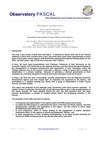Kent County, England
Kent is defined for the purposes of this project as the area covered by Kent County Council, which is an ‘upper tier’ local authority within the English local government system. The current boundaries cover the majority of the historic county of Kent, which has existed as a geographical and political unit for centuries. These boundaries have been largely unchanged for many years, although a reform of the local government system in 1998 resulted in the establishment of a separate authority for the Medway Towns, the county’s largest urban conurbation.
Kent has a population of 1,394,700 (1,646,900 if the Medway Towns are included). The county is polycentric, with no single dominant urban centre, and stretches from the southern fringes of London to the English Channel and North Sea coasts. GDP per capita is around 12% lower than the UK national level and the county has undergone significant economic restructuring over the past 25 years.
Politically, the County Council has responsibility for sub-national road infrastructure, schools, social services, some aspects of development and a range of community services. These are delivered within a strong national administrative context with no legislative devolution below national level. At more local level, Kent contains twelve districts, which retain powers in relation to (primarily) housing and land use planning.
Kent has an area of 3,544 sq km, essentially covering the area from the south east of London to the Channel coast. Much of the county’s rural area is covered by national and international environmental designations, including the Kent Downs and part of the county’s estuarial and coastal marshes. Parts of West Kent also fall within the protected green belt around London. There are therefore significant environmental constraints on development, although the quality of the county’s environment plays an important role in Kent’s desirability as a place to live and in its attractiveness for tourism.
Although 85% of the county’s land area is rural, some 69% of the population live in urban settlements. There is no single dominant urban settlement, with ‘regional capital’ functions dispersed (for example, the county’s administrative centre is at Maidstone, while the main university location is at Canterbury).
 Printer-friendly version
Printer-friendly version- 205 reads










